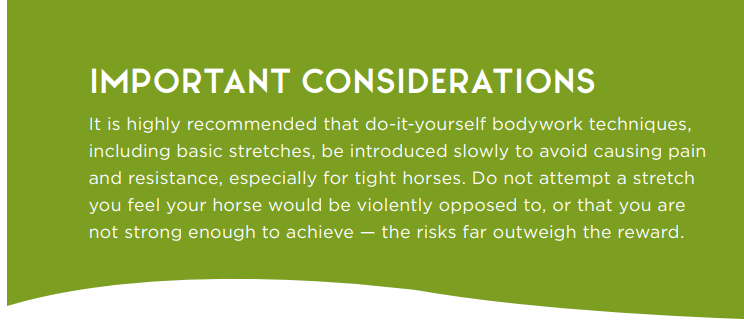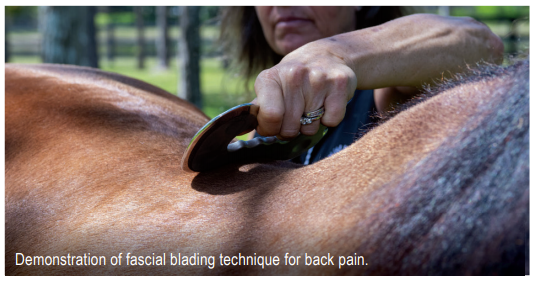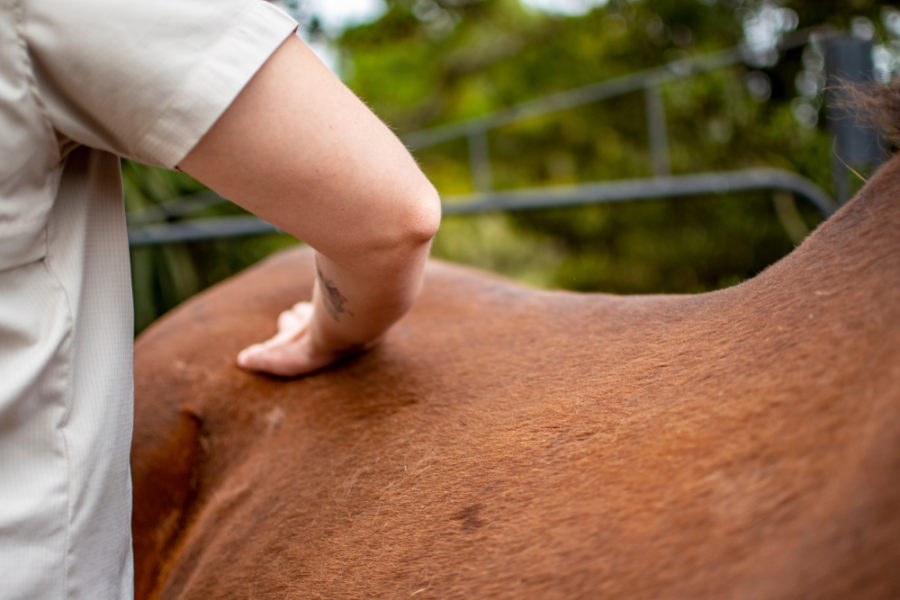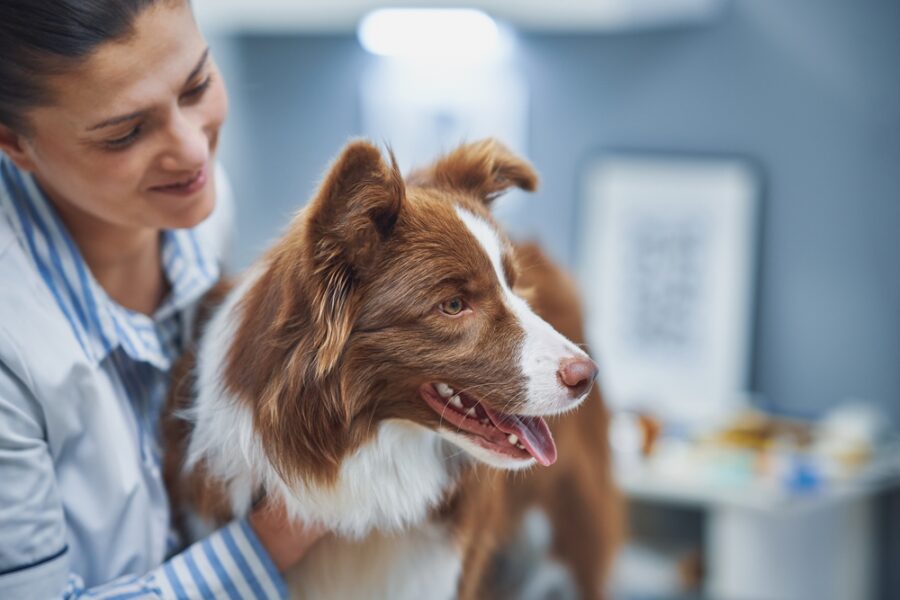Try these simple do-it-yourself approaches to enhancing mobility in your equine companion.
As specialists in equine performance medicine, we have observed – case after case and in all disciplines – a critical factor that significantly influences a horse’s mobility. That factor is how dedicated the caretaker/rider/trainer is to making and maintaining improvement. No matter how many specialists are involved (sports medicine vets, chiropractors, acupuncturists, massage therapists, etc.), the best outcome always relies on a dedicated caregiver taking an active daily role. In this article, we will discuss approaches you can add to your repertoire to maintain your horse’s suppleness, enhance her mobility, and ultimately increase performance and athletic longevity.
Assess your horse’s immobility
Use your senses
When attempting to increase mobility in a horse, it is first essential to understand what is restricted. We very often hear complaints that are general in nature: “My horse does not bend in one direction”; “My horse bulges out through the turn”; “My horse does not engage her hind end”. When considering biomechanics, any one of these complaints can have a multitude of underlying origins and compensatory factors. Often, what we see from the ground or feel in the tack is the sum of a vast equation.

Use palpation
Ultimately, any pain or excess tension in any tissue will negatively impact a horse’s mobility. To get to the root of a given issue, it is invaluable for any horseperson to practice palpation; not only to localize discomfort and restriction, but also to assess how your horse is progressing through therapy. Whether applying liniment or implementing stretching, kinesiology taping, or fascial massage, palpation is your guide.
When learning to palpate, be mindful of your contact and avoid making it offensive. Introduce what you are doing slowly, so you do not confuse, startle, or cause the horse anxiety. Before worrying about interpreting what you feel through your fingertips, focus on an approach that builds trust and respect. Though horses are robust creatures capable of withstanding significant pressure applied by the human hand, palpation should be introduced in a manner that does not elicit a negative reaction.

All contact should begin lightly while maintaining positive and soothing verbal communication. Avoid poking with the tip of one finger; rather, use the tips of several fingers to gently contact an area and then slowly increase the downward pressure. A relaxed muscle should have a medium density if well-toned, and should deform under pressure without any sudden contraction. Flinching or tensing can be due to surprise, so all reactions should be verified through repetition with the same style of contact. Moving away from pressure, either locally or globally, is a sign of acute or active pain. Extreme firmness without notable discomfort is an indicator of chronic misuse and tension.
 As you learn your horse’s body from a fingertip perspective, subtle changes will begin to stand out. While interpreting these observations takes time to understand, the training of your own sensitivity is an invaluable tool that will serve you and your horse for the long term. And if you happen to already enlist the services of a bodywork specialist, it is highly advisable that you ask them to demonstrate to you the areas that feel tight, sore, or abnormal so you can gain from their experience.
As you learn your horse’s body from a fingertip perspective, subtle changes will begin to stand out. While interpreting these observations takes time to understand, the training of your own sensitivity is an invaluable tool that will serve you and your horse for the long term. And if you happen to already enlist the services of a bodywork specialist, it is highly advisable that you ask them to demonstrate to you the areas that feel tight, sore, or abnormal so you can gain from their experience.
Establish his mobility – a hands-on routine
It may sound overly basic, but there is no getting around it – all athletes need to stretch! And the sport horse is most definitely an athlete. His body is comprised of all the same muscles, bones, and connective tissues as our own, so it should be easy to see that this essential component of every human fitness activity also applies to the horse.
The neck and back
Easiest to begin with are the neck and barrel stretches commonly referred to as “carrot stretches”. The name refers to the best method of incentivizing your horse to participate in a series of motions that can be physically difficult and uncomfortable to achieve, but ultimately worthwhile to his health. While the carrot is ideal for protecting your fingers from getting chomped, due to its length, any treat your horse is particularly fond of will serve the purpose.
When asking your horse to perform bends to the various locations in this stretching regimen, the most important element is not whether he reaches the desired location with his lips, but how he gets there. Horses are notorious cheaters, and when it comes to pain versus treat drive, they may not be able to resist the desire for sugary snacks and will find the path of least resistance or briefest discomfort. This runs entirely counter to the principles of good stretching. Think of any part of your own body you have stretched when tight or sore; the goal is never to fling, bounce, or contort to an arbitrary location. When asked to “touch your toes” as a low back and hamstring stretch, it clearly does not count if you bend your knees, nor is it beneficial to you if you throw all your effort into one rapid plunge, graze your toes, and fly back up to vertical.
A stretch should be taken slowly along the proper anatomical path to the point of tension, and then leaned into for several seconds to elicit lengthening of the restricted tissues before slowly returning to neutral. In the case of stretching a horse’s neck and back, common mistakes include allowing the horse to rotate at the poll rather than bend through the cervical spine, or frantically lunge through the motion to get the treat and rapidly return. For each bending position of the carrot stretch (to the wither, to the shoulder, to the knee, to the chest, and to the stifle) watch for the location along the bend at which your horse begins to struggle and deviate from the proper path. Return him to this point and hold for several seconds, ask him to increase the bend a slight degree further, then release. Over time, these incremental gains will add up to a significant increase in mobility.

The most important areas to address with stretching for ultimate horse mobility can be simplified to the neck, the shoulder/wither, the back, and the hind limbs.
The low back and pelvis
This next technique deals primarily with engagement of the topline rather than its ability to bend laterally. By asking your horse to lift her topline and flex her pelvis, you are achieving numerous benefits, such as opening the intervertebral spaces of the thoracic and lumbar spine, strengthening the core muscles of the lower abdomen and hind limbs, and stretching the topline epaxial muscles.
We refer to this technique as the “butt tuck”, and it is achieved by tracing with light to deep pressure from alongside the horse’s sacrum (croup) toward the hip joint in the belly of the gluteal muscle. Both sides must be contacted simultaneously, though it may require different levels of pressure applied by each hand to direct the horse to engage her hind end squarely with equal effort from both hind limbs. If your horse is flexing to one side rather than engaging the spine upward, increase pressure with the hand that the haunches are moving toward, and/or reposition the stance of the hind limbs until both are extending equally upward. When done slowly and held at the peak of contraction, this motion becomes an isometric exercise that both enhances the suppleness of the low back and strengthens the core.

The shoulder and hind limbs
While mobilizing these two areas is of immense structural benefit, it must be approached with extreme caution. Even horses that are willing and responsive to these stretches can pose serious risks to your safety. Due to the advanced nature of these techniques, it is advised that you seek more in-depth training and/or direct supervision before attempting them.
By incorporating these techniques, with minimal introduction, dedicated caretakers could easily equip themselves with a powerful toolset to extend and enhance the benefits of any bodywork provided to their horses. Understanding where restrictions in mobility are rooted within your horse’s body opens up a wide realm of treatment options, and close monitoring focuses your efforts on those that have the greatest positive effect.
Visit equalign.com for further info and courses.








